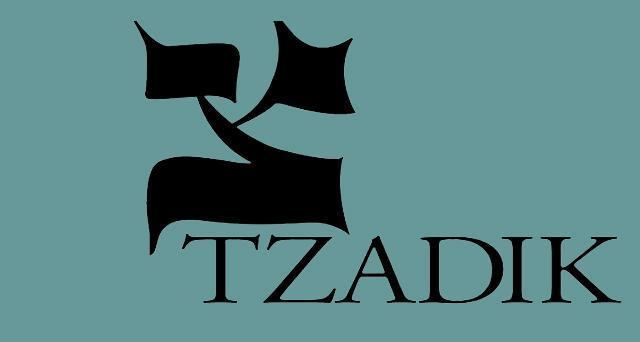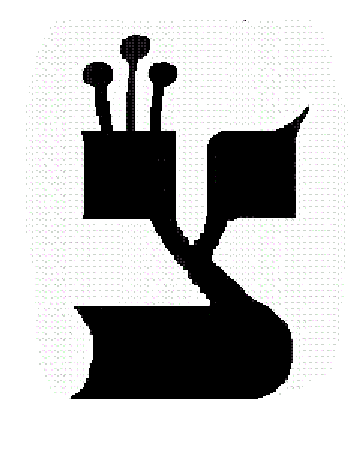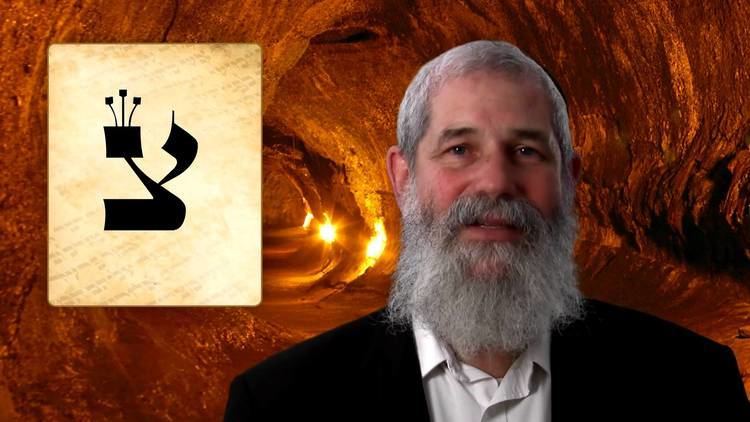 | ||
Tzadik
Tzadik/Zadik/Sadiq [tsaˈdik] (Hebrew: צדיק, "righteous one", pl. tzadikim [tsadiˈkim] צדיקים ṣadiqim) is a title in Judaism given to people considered righteous, such as Biblical figures and later spiritual masters. The root of the word ṣadiq, is ṣ-d-q (צדק tzedek), which means "justice" or "righteousness", also the root of tzedakah ('charity', literally 'righteousness'). The feminine term for a righteous person is tzadeikes/tzaddeket.
Contents
- Tzadik
- Etymology
- Definitions of a Tzadik
- The Tzadik Nistar Concealed Tzadik
- The Tzadik HaDor Tzaddik of the Generation
- Baal Mofes Miracle workers
- Becoming a Tzadik
- Identification with Yesod
- Intellect in the supernal soul of the community
- References

The term tzadik "righteous", and its associated meanings, developed in Rabbinic thought from its Talmudic contrast with hasid ("pious" honorific), to its exploration in Ethical literature, and its esoteric spiritualisation in Kabbalah.

Since late 17th Century, in Hasidic Judaism, the institution of the mystical tzadik as a Divine channel assumed central importance, combining popularization of (hands-on) mysticism with social movement for the first time. Adapting former Kabbalistic theosophical terminology, Hasidic thought internalised mystical experience, emphasising deveikut attachment to its Rebbe leadership, who embody and channel the Divine flow of blessing to the world.

Etymology

Arabic ṣādiq (صادق) and Ethiopic Tsaddəq (ጻድቅ), are cognates with similar meaning. The title of Voltaire's satirical novel Zadig also stems from this root. Ṣedeq "Righteousness" in Canaanite religion may have been an epithet of a god of the Jebusites. The Hebrew word appears in the biblical names Melchizedek, Adonizedek, and Zadok, the high priest of David.
Definitions of a Tzadik
In classic Jewish thought, there are various definitions of a tzadik. According to Maimonides (based on Tractate Yevamot of the Babylonian Talmud 49b-50a): "One whose merit surpasses his iniquity is a tzadik".
According to the Hasidic Tanya (based on passages in Tanakh and the Talmud, and the tradition in Kabbalah), the true title of tzadik denotes a spiritual description of the soul. Its true meaning can only be applied to one who has completely sublimated their natural "animal" or "vital" soul inclinations into holiness, so that they experience only love and awe of God, without material temptations. Hence, a tzadik serves a "vehicle" or "merkavah" [מרכבה] {Tanya ch.23} to God and has no ego or self-consciousness. Note, that a person cannot attain such a level, rather it is granted from on High (or born with, etc.)tanya ch.27. This select level elevates the "Intermediate" person ("Benoni") into one who never sins in thought, speech or action. Unlike the Tzadik, they only experience Divine communion during devoted moments of worship or study, while in mundane life they can be tempted by natural inclinations, but always choose to stay connected to holiness. In the Tanya the difference between the former Talmudic-Maimonidean and latter Kabbalistic-Hasidic conceptions is raised. Since the "Torah has 70 facets" of interpretation, perhaps both conceptions are metaphysically true:
As for what is written in the Zohar III, p.231: He whose sins are few is classed as a "righteous man who suffers", this is the query of Rav Hamnuna to Elijah. But according to Elijah's answer, ibid., the explanation of a "righteous man who suffers" is as stated in Raaya Mehemna on Mishpatim, which is given above. (Distinguishing 2 levels of Tzadik: The "righteous who prospers"-literally "good to him" is interpreted to mean that the natural soul in him has become "his own-transformed to good". The "righteous who suffers"-literally "bad to him" is interpreted to mean that his natural soul still exists in his unconscious, but is nullified to his Divine soul, "the bad-is under him") And the Torah has seventy facets. (So the reason for the question)
The Tzadik Nistar-Concealed Tzadik
The Talmud says that at least 36 Tzadikim Nistarim—anonymous tzadikim—are living among us in all times; they are anonymous, and it is for their sake alone that the world is not destroyed. The Talmud and the Kabbalah offer various ideas about the nature and role of these 36 tzadikim. In Jewish folklore they are called "lamedvovniks", from the gematria numerical value for 36. In Hasidism, with its social institution of the Tzadik in the central role of the community, the 36 may not necessarily be unknown, therefore. However, a Hasidic aphorism describes a known Rebbe Tzadik as being among the 36, as their true greatness could be concealed beyond the perception of their devoted followers.
The Tzadik HaDor-Tzaddik of the Generation
Hasidim adhere to the belief that there is a person born each generation with the potential to become Messiah, if the Jewish people warrant his coming. This candidate is known as the Tzadik Ha-Dor, meaning Tzaddik (a Hebrew term literally meaning "righteous one" but used to refer to holy men who can, for example, perform miracles or act as a "pipeline" between man and God) of the Generation.
Baal Mofes-Miracle workers
While the tzadik status, according to its above definitions, is not necessarily related to the ability to perform or call upon miracles, the term tzadik is often used loosely by the Talmud to indicate those who have achieved especially outstanding piety and holiness. In this context, the tzadik's prayers are considered especially potent, as the Talmud states: "A tzadik decrees and the Holy One (blessed be He) fulfills." This is line with the talmudic dictum: Rabban Gamliel the son of Rabbi Judah haNasi used to say: "Make His Will your own will, that He make your will as His Will."
In some contexts, people refer specifically to the pious miracle-worker as a tzadik. According to the Baal Shem Tov, it is said, this ability is attainable for every Jew. It is told that he stated that every Jew has the power to cross a river atop a handkerchief [source?], through connecting with their soul (which is divine in essence). In Hasidism, the doctrine of "Practical Tzadikism", developed by Elimelech of Lizhensk, involved the Tzadik performing miracles to channel the Ayin-Yesh Divine blessing. In its most extreme version, Hasidic "wonder-workers", predominant in 19th century Poland, emphasised this conception, sometimes criticised by other Hasidic leaders as superficial. To Menachem Mendel of Kotzk, and his reaction against Popular Tzadikism, the greatest miracle was to examine oneself without self-delusion.
Becoming a Tzadik
According to the first definition above, that a tzadik is "one whose merit surpasses [their] iniquity." According to the definition of the Tanya that a Tzadik has no evil inclination, only a select few predestined to attain this level can attain it.
Identification with Yesod
"..For all that is in Heaven and on Earth.."
"-For all כל (Yesod) joins the Heaven and the Earth"
"The Tzadik is the foundation (Yesod) of the World"
In the system of 10 Sephirot Divine emanations in Kabbalah, each of the 7 emotional expressions is related to an archetypal figure in the Hebrew Bible. The first emanated realm to emerge from God's potential Will in Creation is Atziluth, the World of "Emanation". As it is still nullified to Divinity, so not yet considered a self-aware existence, it is the realm where the 10 Sephirot attributes of God are revealed in their essence. In lower spiritual worlds the sephirot also shine, but only in successively lower degrees, concealed through successive contractions and veilings of the Divine vitality. Seven Biblical tzadikim, righteous figures are considered as embodiments of the emotional sephirot of Atzilut: Abraham-Kindness, Isaac-Restraint, Jacob-Mercy, Moses-Endurance, Aaron-Glory, Joseph-Foundation, David-Kingship. While all seven figures are considered supreme Tzadikim, in particular contexts, either Joseph as Yesod, and Moses as inclusive soul of the community, are identified especially as archetypes for the Tzadik in general.
In the sephirot, Chesed-Abraham, Gevurah-Isaac and Tiferet-Jacob are higher spiritual powers than Yesod-Joseph, which channels the higher powers to their fulfilment in Malchut action. However, traditionally in Judaism, Joseph is referred to with the quality of "Tzadik-Righteous". While the Patriarchs lived righteously as shepherds, Joseph remained holy in Egypt, surrounded by impurity, tested by Potiphar's wife, captive in prison, and then active as viceroy to Pharaoh. As the Heavenly sephirah of Yesod-"Foundation" channels spirituality to our physical realm, so in Kabbalah and the further development in Hasidic thought, its function also parallels the human role of the Tzadik in this world:
Intellect in the supernal soul of the community
"..To love the Lord your God, to listen to His voice, and to cleave to Him.."
"Cleaving to a Torah scholar is as cleaving to the Divine Shechinah"
The leaders of Israel over the masses stem from the intellect of Adam's soul
"In every generation there is a leader like Moses"
